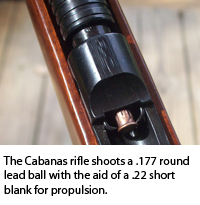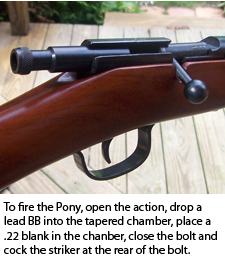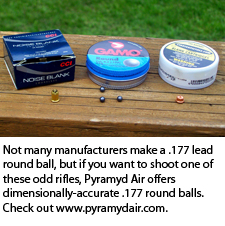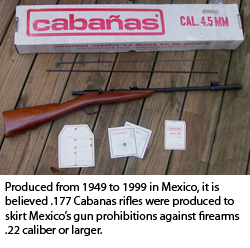
I’ve always been intrigued by the offbeat. When I was in seventh grade I had to express an interest in some sort of field for a career day event at school. The other children chose the usuals: law enforcement, medical and education. Me, I chose mortuary science, a choice that eventually paid off inasmuch as it kept me in pizza and Stroh’s while working my way through college at a series of Indiana funeral homes.
Given my penchant for the unusual, it’s no wonder that throughout my early adult years, I was intrigued by entries such as this, which appeared in the catalog section of the 1988 Gun Digest:
CABANAS MASTER BOLT ACTION RIFLE Caliber: 177, round ball or pellet; single shot. Barrel: 191/2 inches. Weight: 8 pounds. Length: 451/2 inches overall. Stock: Walnut target-type with Monte Carlo. Sights: Blade front, fully adjustable rear. Features: Fires round ball or pellet with .22-caliber blank cartridge. Bolt action. Imported from Mexico by Mandall Shooting Supplies. Price: $150. Cabanas Leyre Bolt Action Rifle. Similar to Master Model except 44 inches overall, has sport target stock. Price: $134.95. Model Mini 82 Youth (161/2-inch barrel, 33 inches overall length, 31/2 pounds) $69.95 Pony Youth (16-inch barrel, 34 inches overall length, 3.2 pounds) $79.95 |
Well, there was something you didn’t see every day: a BB gun that didn’t use compressed air or gas as a propellant, but a .22 blank cartridge. Obviously, there could be no practical use for such a gun — which meant, of course, that I just had to have one.
The idea of such a blank-fired BB gun wasn’t entirely original with the Cabanas company. More than a century earlier, Europeans had used similar guns for a sport called zimmerschutzen — literally, “indoor room shooting” or parlor shooting. These guns used a percussion cap to fire a tiny lead ball, usually a lead BB shot, at velocities suitable for indoor target practice.
 Oddly, the great Italian maker Pedersoli makes a reproduction of a typical European zimmer pistol from the mid-1800s. Over here in the United States, Remington made about 200 Remington-Rider derringers from 1860 to 1863; this odd little duck also used a percussion cap to fire a .177 lead ball. Today, a close copy of this tiny pistol is being produced in limited numbers, again by Pedersoli.
Oddly, the great Italian maker Pedersoli makes a reproduction of a typical European zimmer pistol from the mid-1800s. Over here in the United States, Remington made about 200 Remington-Rider derringers from 1860 to 1863; this odd little duck also used a percussion cap to fire a .177 lead ball. Today, a close copy of this tiny pistol is being produced in limited numbers, again by Pedersoli.
Really now! Except for replicas, the idea of using a cap or a .22 blank to fire a lead ball must have died 100 years ago. Hadn’t it?
Apparently not, if these Cabanas really existed. I vowed that I would get my hands on one.
I am nothing if not patient. It took me nearly 20 years to own a Cabanas, but here I sit today with not just one of them, but three. Here’s how it happened: I was painfully slogging through the Standard Catalog of Firearms, which I edit, running value checks on the tens of thousands of guns listed in the book.
At the beginning of the “C” chapter, I hit on the listing for “Cabanas” — more properly known as Industrias Cabanas, S.A. of Aguilas, Mexico — and I remembered the old Gun Digest entries. Several models were listed in Standard Catalog, so I took a quick drive on the information superhighway to see if it would lead me to more information about Cabanas guns.
Lo and behold, on the Web site of one of Gun Digest the Magazine’s most prominent advertisers (hint), I found Cabanas guns up for auction at reasonable prices. I placed some bids, and the rest, as they say, is history.
So now I own a small flock of Cabanas rifles. Considering that these guns are rather scarce on this side of the Rio Grande, I suppose that makes me northern Indiana’s Cabanas king. A king, maybe, but not an expert.
Background, Origins
 I can tell you that Cabanas Industrias, S.A. translates into Cabin Industries Inc. The company was in business from about 1949 to 1999, and Cabanas guns are fairly well known in Mexico’s limited shooting circles. But because of the language barrier, it’s tough for me — an aw-shucks Hoosier who barely speaks English — to research the company in depth.
I can tell you that Cabanas Industrias, S.A. translates into Cabin Industries Inc. The company was in business from about 1949 to 1999, and Cabanas guns are fairly well known in Mexico’s limited shooting circles. But because of the language barrier, it’s tough for me — an aw-shucks Hoosier who barely speaks English — to research the company in depth.
For example, here is part of a Mexican internet discussion thread concerning the Cabanas R83 single-shot pistol. I translated it from the original Spanish with the help of free online software:
“In the case of this pistol, I have noticed that has certain detail in its operation, perhaps I am making the things bad, them comment since I hope to make understand me not to know the terms suitable. When wanting to load the pistol, I have only managed to make a shot, since after this, the part that is hauled backwards not is on guard to leave lists it towards the following firing, I leave a good short while it and later it is possible again to be driven. Serian so amiable to help me with this problem. Greetings from Mexico!”
Well, greetings to you, too! I have read that probably 20 times, and it still baffles me. I gather there’s a problem with this fellow’s pistol, specifically with the part that is hauled backward when it “lists it toward the following firing.” However interesting that might be, it’s not very illuminating.
I got my NIB/NOS (new-in-the-box, new old stock) Cabanas (pronounced “ka-BAN-yus”) peashooters from an exceedingly polite gentleman named Dave Guthridge of Sioux City, Iowa. Three or four years ago, Dave bought out some of the inventory of the now-defunct Mandall’s Shooting Supplies of Scottsdale, Ariz., and it included dozens of Cabanas guns and parts. Dave squirreled away these oddballs and is selling them one by one.
Although Dave couldn’t tell me much about the Cabanas company, the guns he sold me included all of the factory literature, which helped shed some light on how these guns function. But it didn’t explain why Cabanas guns were made in the first place.
The answer apparently lies in Mexico’s strict laws against civilian ownership of firearms. In Mexico, your average man in the street is forbidden from owning most cartridge-firing arms of .22 caliber and larger, a situation that varies slightly according to the whims of geography and politics. Where gun ownership is allowed, it’s limited pretty much to rimfire rifles, and the process of buying even these is layered in bureaucratic red tape.
Cabanas guns represented a clever way to let shooters bang away with something more substantial than airguns. Because Cabanas guns are .177 caliber, they evade Mexico’s .22-caliber restriction. And because they don’t fire fixed ammunition, they aren’t considered firearms.
In Mexico, that is. Here it’s a different story. Our friends at the U.S. Bureau of Alcohol, Tobacco, Firearms and Explosives apparently consider the Cabanas to be a firearm, according to this definition:
“DEFINITION OF “FIREARM”: 18 USC § 921(a)(3), (4). Any weapon (including a starter gun) which will expel a projectile by means of an explosive or is designed or may be readily converted to do so.”
The fact the BATFE considers a Cabanas a firearm probably explains the guns’ lack of popularity in the United States. Who wants to go through the hassle of all that paperwork simply to own a hot-rodded BB gun?
But a Cabanas is no more a toy than is a modern air rifle. An 8.2-grain lead BB propelled at the Cabanas’ advertised muzzle velocity of 1,100 feet per second (more about that later) yields a muzzle energy of 22 foot-pounds, compared to about 35 foot-pounds for the .22 Short standard load with its much heavier bullet.
Projectiles
 In attempting to learn more about the Cabanas, I learned that not all .22 blank cartridges are created equal. In Mexico, apparently, they have (or had) little plastic-cased blank ammo called Floberts that were made specifically for the Cabanas.
In attempting to learn more about the Cabanas, I learned that not all .22 blank cartridges are created equal. In Mexico, apparently, they have (or had) little plastic-cased blank ammo called Floberts that were made specifically for the Cabanas.
These cartridges may have provided the necessary “give” to let them chamber in a Cabanas, but I’ve found that American-made brass-cased .22 can be a tight fit in the chamber of these odd little guns.
CCI makes a star-crimped smokeless .22 blank that approximates the length of a .22 Short case. Winchester offers similar black-powder blanks, but I hesitate to use them since I don’t enjoy cleaning black-powder fouling. Gun Dog Supply of Starkville, Miss., offers what they call their “acorn blank;” a cute little crimped nubbin of a load that produces less noise than a standard blank. I found that the CCI blanks are a tight fit in all my Cabanas guns — a situation that improves as the gun is broken in — but the Gun Dog Supply acorn blank does all right.
It eases into the chamber like it was meant to be there.
Projectiles were another challenge. Not many manufacturers offer dimensionally-correct .177-inch lead balls for airgun use, and I wasn’t about to sit down with a 5-pound bag of lead BB shot and a micrometer.
Luckily, I discovered that Pyramyd Air of Bedford Heights, Ohio (www.pyramydair.com), offers Gamo .177-inch lead balls and assorted lead diabolo (skirted) pellets, so I ordered a representative sampling and had them on my doorstep five days later.
 About using lead pellets in Cabanas guns: The hang tag that came with one of my Cabanas rifles has strict instructions about the use of other than round lead balls. Here’s what the tag says:
About using lead pellets in Cabanas guns: The hang tag that came with one of my Cabanas rifles has strict instructions about the use of other than round lead balls. Here’s what the tag says:
“Por ningun motivo introduzca mas de uno municion al efectuar su disparo. No utilice de acero ni diavolos de ningun otro tipo.”
My free online software, which I am rapidly coming to distrust, translates this as:
“By ningun reason introduces but of the one ammunition when carrying out its firing. It does not use of steel nor diavolos of ningun another type.”
That’s a big help. I never took high-school Spanish, but even I can figure out that the tag is saying something like, “Do not use steel bullets or diabolo pellets.” But maybe there’s a misplaced modifier kicking around in there. Does it mean that you can’t use steel bullets (that is, steel BBs) or steel diabolo pellets, or does it mean that you can’t use diabolo pellets at all, even lead ones? Anybody?
My Cabanas rifles range from the bottom of the line to a fairly advanced model. The most modest is the Pony. It’s about as simple a gun as you could ask for: a single-shot bolt-action rifle with straight-gripped hardwood stock. It doesn’t have a safety, and its trigger can’t be adjusted, though the rear sight is adjustable for elevation.
To fire the Pony, you open the action and drop a lead BB into the tapered chamber. Then you place a .22 blank in the chamber — not an easy task with my sausage-like fingers — and close the bolt. You then cock the striker knob at the rear of the bolt, squeeze the trigger, and bang.
To extract the empty case, you pull back on the manual extractor, a ribbed collar that surrounds the barrel just forward of the chamber. Two spring-steel prongs then pop the empty out of the chamber, and you poke it with your finger to clear it. All of the Cabanas blank guns function in this same general way.
One step up from the Pony is the Mini 82. The Mini is quite similar to the Pony but has a flared muzzle extension attached to it that looks like a suppressor but is actually a barrel weight. The Mini also has an adjustable trigger, a hooded front sight and a curved butt. If you didn’t know better, you’d think the Mini was some sort of CIA black-ops hypodermic gun or something.
Next comes the Leyre. It looks like a real gun, with its target-style stock with cheekpiece. It also has an adjustable trigger, a manual safety, a bolt that automatically cocks on closing and a receiver that’s grooved for scope mounts. With the Leyre, you also get a real buttplate; something the Pony and Mini lack.
 First up was the Mini. I charged it with a Gamo lead ball and CCI blank. Pop! Two inches high and left of center. Pop! Two inches high, center. Pop! Two inches high and one inch left. Friends, that’s not much of a group. Any decent airgun could do better.
First up was the Mini. I charged it with a Gamo lead ball and CCI blank. Pop! Two inches high and left of center. Pop! Two inches high, center. Pop! Two inches high and one inch left. Friends, that’s not much of a group. Any decent airgun could do better.
I then tried the acorn blanks; same group but not as high. I then tried some Beeman diabolo pellets (Crow Magnums) and discovered what the Spanish hang tag meant: Don’t use diabolo pellets, lead or not! The pellets keyholed and some never even found the paper. What’s worse, two pellets left their skirts in the bore (which is the first time in my life I ever objected to having an empty skirt around). Any thoughts I had about hunting with a Cabanas went flying into the woods, along with a half-pound of Gamo 177-inch round balls and a few pellets.
The results from the hour-long shooting session were disappointing. My chronograph revealed that the muzzle velocity from the acorn blanks ranged from 703 fps to 830 fps with a lead round ball. The CCI blanks were magnums by comparison, yielding an average muzzle velocity of 1,041 fps. Not bad velocity, really, but again, there are plenty of decent pellet guns that can do better.
Itemized Cabanas
 I’ve assembled a partial list of Cabanas models, but it is probably incomplete. At the very least, Cabanas offered the Model 82 Mini, Pony, Leyre, Master, Espronceda IV (similar to the Leyre but with a full-length sporter stock), and Laser (similar to the Leyre but with a thumbhole stock and finger-grooved pistol grip), which might have been identical or very similar to the so-called Phaser and Taser models. (Phaser and Taser strike me as American-style marketing labels that Mandall applied to the guns rather than Cabanas factory designations.)
I’ve assembled a partial list of Cabanas models, but it is probably incomplete. At the very least, Cabanas offered the Model 82 Mini, Pony, Leyre, Master, Espronceda IV (similar to the Leyre but with a full-length sporter stock), and Laser (similar to the Leyre but with a thumbhole stock and finger-grooved pistol grip), which might have been identical or very similar to the so-called Phaser and Taser models. (Phaser and Taser strike me as American-style marketing labels that Mandall applied to the guns rather than Cabanas factory designations.)
Rounding out the line was the Model R83 pistol, a futuristic-looking little bolt-action. (Ever the glutton, I’ve got an R83 on order from Guthridge.) All of these Cabanas guns had hardwood stocks of varying degrees of quality and finish.
Cabanas apparently went down for the third time in 1999, but before the waves closed over them, they had time to manufacture a line of more or less conventional hinged-barrel, air-powered 177-inch pellet guns called the Model 210 Sport. The Sport guns had brightly enameled stocks that certainly make them stand out in a crowd. Guthridge will be happy to tell you about these interesting Cabanas pneumatics, and you can e-mail him at [email protected] for more information.

Next Step: Get your FREE Printable Target Pack
Enhance your shooting precision with our 62 MOA Targets, perfect for rifles and handguns. Crafted in collaboration with Storm Tactical for accuracy and versatility.
Subscribe to the Gun Digest email newsletter and get your downloadable target pack sent straight to your inbox. Stay updated with the latest firearms info in the industry.

![Best Concealed Carry Guns In 2025 [Field Tested] Wilson Combat EDC X9S 1](https://gundigest.com/wp-content/uploads/Wilson-Combat-EDC-X9S-1-324x160.jpg)


![Best 9mm Carbine: Affordable PCCs [Tested] Ruger Carbine Shooting](https://gundigest.com/wp-content/uploads/Ruger-Carbine-Shooting-100x70.jpg)
![Best AR-15: Top Options Available Today [Field Tested] Harrington and Richardson PSA XM177E2 feature](https://gundigest.com/wp-content/uploads/Harrington-and-Richardson-PSA-XM177E2-feature-100x70.jpg)

Hello, Dan, excelent article there. Im from México and I can help you to translate any information you need about the Cabañas Rifles. About the diabolos, you can use any diabolo with the rifle, the only condition is that you seal the skirt of the diabolo with some filling putty that hardens once put. I do this with polyester resin, but it can be done with epoxy, or even lead. Once this is done for every diabolo you would shoot, the skirt will no longer get stuck in the chamber. This is a trick that all the Cabañas shooters know here in Mexico. My e-mail is [email protected] I´ll be glad if you e-mail me.